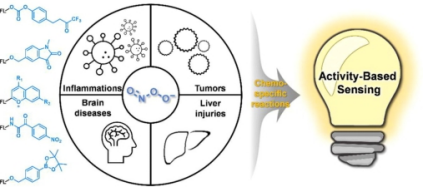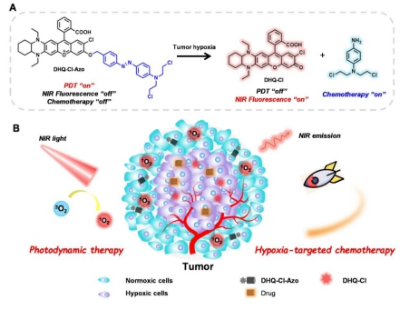New Advances Made in Molecular Diagnosis and Precision Medicine by Prof. Liu Zhihong’s Team.
Author: School of Chemistry and Chemical Engineering Editor:Xian Wentao
Source: School of Chemistry and Chemical Engineering Released on: 2022/02/04
Recently, continuous advances have been made in molecular diagnosis and precision medicine by Prof. Mao Zhiqiang and Prof. Liu Zhihong’s team, the first authors working in Hubei University, whose outcomes have been published in Matter (sub-publication of Cell, Impact Factor: 15.589) and the leading international review journal Coordination Chemical Reviews (Impact Factor: 22.315).
Reactive Oxygen Species (or ROS) is a group of small molecules chemicals commonly found in living organisms, which are widely involved in various biochemical processes and are closely relevant to the development of various diseases. Owing to the diverse composition of the ROS, short presence (~ns-ms) in living organisms and the interconversion between ROS, it is still a major challenge for researchers in accurate spatio-temporal detection of ROS in intricate biological systems and the exploration of the relationship between reactive oxygen species and diseases at the intersection of chemistry, biology, and medicine.
In response to the major challenge, molecular imaging assisted by activity-based sensing (ABS) fluorescent probes have been designed and made for conducting research into the molecular mechanisms, diagnosis, and treatment of disease.(Analytical Chemistry 2021, 93,3035-3041;Analytical Chemistry 2020, 92, 13305-13312; ACS Sensors 2020, 5, 3237-3245;Chemical Communications 2019, 55, 12912-12915;Analytical Chemistry 2017, 89, 9620-9624; Chemical Science 2018,9, 6035-6040; Chemical Science 2017, 8, 4533-4538; Chemical Science 2016, 7, 5230-5235 etc.). Recently, the team has systematically summarised the work of fluorescent probes that have detected peroxynitrite (ONOO—, one of the ROS), and has a detailed review of the advances in research linking peroxynitrite to different diseases (like Inflammations, Tumours, Liver injuries and Brain diseases.). Their team also summarised the limitations and pressing issues in the design of current fluorescent probes for disease detection and provides an outlook on the research area. The review was published in the Coordination Chemical Review under the title "Activity-based fluorescence probes for pathophysiological peroxynitrite fluxes", with Associate Professor Mao Zhiqiang as first author, and Prof. Liu Zhihong and Prof. Jong Seung Kim as co-corresponding authors.

Coordination Chemistry Reviews 454 (2022) 214356.https://doi.org/10.1016/j.ccr.2021.214356.
Cancer is one of the most common diseases that threatens human life and health, with 10 million people dying of cancer worldwide in 2020 alone. Despite the traditional radiotherapy, chemotherapy and surgery, researchers have developed a variety of treatments for tumours in recent years, such as phototherapy, gene therapy and immunotherapy. However, due to the extreme complexity of the tumour microenvironment in the body, the effectiveness of these treatments has not yet meet the expectation. The research team has recently designed a new integrated molecular therapy platform to address the challenge of tumour treatment by exploiting the biological characteristics of solid tumours, which are rich in oxygen at the periphery but lack oxygen inside.

Matter, 2022, accepted
By using the molecular therapy platform to deliver photodynamic therapy to the periphery of solid tumours, followed by targeted chemotherapy with intra-tumoral enzyme activation, researchers overcame the shortcomings of single photodynamic therapy or chemotherapy, significantly improving the efficiency of solid tumours and achieving satisfactory treatment results. Besides, when activated by azo reductase in the tumour microenvironment, the therapeutic molecule specifically releases NIR fluorophores within the tumour, allowing simultaneous fluorescence visualisation of the tumour for diagnosis. The review was published in the Matter under the title “Engineering a theragnostic platform for synergistic hypoxia-responsive photodynamic therapy and chemotherapy”. Xiong Jianhua, a master’s student in the School of Chemistry and Chemical Engineering, Hubei University, Class of 2018, is the first author of the paper, with Associate Professor Mao Zhiqiang, Professor Liu Zhihong and Professor Jong Seung Kim of Korea University, ROK, as co-corresponding authors.
All the above research was funded by the National Natural Science Foundation of China and the Natural Science Foundation of Hubei Province.
(Reviewed by: Zhang Xiuhua)